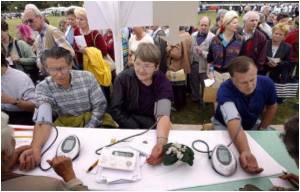
Scientists have long thought these receptor proteins, which bind to glutamate to activate the flow of ions through the nervous system, are more than simple 'on-off' switches.
A 'cleft' in the AMPA protein that looks and acts like a C-clamp and that binds the neurotransmitter glutamate may, in reality, serve functions at positions between fully open (off) and fully closed (on).
"In older days, the binding was thought to be like a Venus flytrap," said Christy Landes, an assistant professor of Chemistry at Rice and lead author of the new paper.
The truth is that the clefts of AMPA receptors are constantly opening and closing, exploring their space for neurotransmitters, she said.
"We know these proteins are super dynamic whether glutamate is present or not. And we need to look at one protein at a time to avoid averaging," she added.
Advertisement
Vasanthi Jayaraman, an associate professor in UTHealth's Department of Biochemistry and Molecular Biology, started the process when she used the binding domain of the AMPA receptor and attached fluorescent dyes to the points of the cleft in a way that would not affect their natural function.
Advertisement
"These experiments had to be done in a box in a dark room. In a short period of measurement, we might be counting 10 photons," she said.
"The amount of light that comes out of the dyes has a direct relationship to the distance between the dyes," said Landes.
Detecting very small changes in the distance between the two points over a period of time required calculations involving wavelets, a tool Rice mathematicians helped develop in the '70s and '80s.
Wavelets allowed the researchers to increase the resolution of FRET results by reducing shot noise - distortion at a particular frequency - from the data.
It also allowed them to limit measurements to a distinct time span - say, 100 milliseconds - during which the AMPA receptor would explore a range of conformations.
They identified four distinct conformations in an AMPA receptor bound to a GluA2 agonist (which triggers the receptor response).
Other experiments that involved agonist-free AMPA or AMPA bound to mutated glutamate showed an even floppier receptor.
Knowing how cleft positions match up with the function is valuable, said Jayaraman, who hopes to extend the technique to other signalling proteins with the ultimate goal of designing drugs to manipulate proteins implicated in neurological diseases.
The study has been reported in the journal Nature Chemical Biology.
Source-ANI














